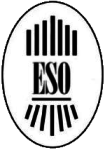A short history of the Society
Founded in 1913, the Edinburgh Society of Organists (or ESO for short) has evolved and survived by adapting to the changing needs of the organists' profession and the needs of church music in general.
When the society was founded by Dr William Baird Ross, esteemed organist of Broughton Place U.P. Church (now Lyon and Turnbull's showroom!), its principal raison d'etre was to give Edinburgh's organists the chance to meet each other and to learn about each other's work and experiences. "Social intercourse and friendly interchange of opinion"; was the first aim of the proposed society, according to an address which Dr Ross gave the first meeting of the new society on 24th June 1913.
The monthly meetings of the society were in the early years the most important means of encouraging the "social intercourse", which Dr Ross saw as a means of dispelling a public perception that there was a certain "aloofness" amongst organists in general. Good attendance at these monthly meetings was both expected and achieved. In the early decades of the 20th century the organist's profession was a secure and well remunerated one, organists were not in short supply, each church had its choir and an army of time-served organ builders was busy all the year round servicing and tuning the pipe organs which stood in the vast majority of churches in the city.
More recent decades have seen the society turn its attention to the need to encourage potential young organists, to negotiate with church authorities over salary scales at a national level, to provide an organ advisory service to help churches maintain their instruments in a cost-effective way, and to provide finance and other initiatives to assist with organists' training. The monthly meetings are still important but now form only a part of the society’s activities.
Dr Ross was adamant that the society should not function as a trade union and that has remained the case until the present day, though at various times in its history the society has not held back from pursuing grievances with church authorities which have treated organists in an unsatisfactory way.
The society has always had an ecumenical membership. The second President, Thomas Collinson was organist of St. Mary’s Episcopal Cathedral, while the fourth, Paul della Torre, played in the Catholic Apostolic Church in Mansfield Place. The ESO’s membership has never been concerned about denominational differences, but rather has learned from these and admired the rich tapestry of liturgical style enjoyed by its various members.
In the early days, nearly all the members of the ESO were practising organists, holding recognised organist’s posts. Those who did not play were Associate members and were perhaps regarded a little differently! The distinction was eventually abolished in 1992 and abut 25% of the membership are now non-players who simply enjoy listening to organ music or are interested in other aspects of church music.
The ESO’s office bearers have always carried out their duties free of charge and it is accepted that no fee can be paid to members for work carried out on behalf of the society. At the hub of the society’s work has always been a hard-working Secretary, on whose work much depends. It might not be invidious to single out former Secretaries, James McGillivray (1937-1952) and Douglas Smart (1968-1980), to whose unbounded enthusiasm the society owes a great deal. Many a treasurer has also contributed hundreds of work-hours to keeping the society’s assets in order, all without remuneration.
A glance through the list of former ESO Presidents from 1913 to the present reads like a Who’s Who of distinguished players. Perhaps the most famous international figure was Alfred Hollins, blind organist of St. George’s Free Church (which became St. Georges West and is now home to Charlotte Chapel). He toured the world as an organ recitalist, while developing a love-hate relationship with the ESO. When he did not get his way at ESO Council meetings, he invariably threatened to resign and the other Council members always appeared to meekly capitulate to his demands. Eventually the problem was solved by making him a life member. However, Hollins had the last laugh. He bequeathed his flat at Haymarket to the ESO, on the condition that the Society could never sell it, and at the same time sent many an office bearer to the brink of nervous exhaustion. However, the result is that the ESO is the most affluent organists’ society in the UK, with the resources to finance many exciting projects.
Membership has risen gradually from about 60 in 1913 to a peak of over 250 in the early 1980s and just over 200 at present. In many respects it is one of the most active of the musical societies which exist in Scotland at the present time.


